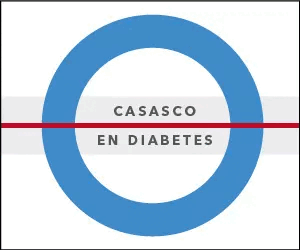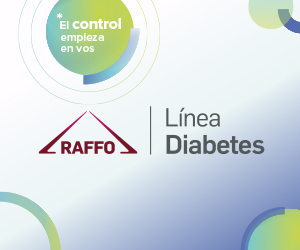Accuracy and reliability of ankle-brachial index measurement using an oscillometric device versus the Doppler method
DOI:
https://doi.org/10.47196/diab.v57i1.662Keywords:
doppler, ankle-brachial index, lower limb ischemiaAbstract
Introduction: the measurement of the ankle-brachial index (ABI) is a first-line test with high diagnostic accuracy for the detection of peripheral vascular disease. The Doppler method, considered the gold standard, requires the device and a trained operator, which limits its use in primary care. Alternatively, an oscillometric method using an automated blood pressure device is a simple and affordable test that could minimize observer bias and eliminate the need for special training.
Objectives: to validate the diagnostic capacity of an automated oscillometric device against the Doppler method for ABI measurement.
Material and methods: diabetes mellitus type 1 and 2 (DM1 and DM2) patients older than 50 years with 1 or more cardiovascular risk factors were included. After 5 minutes lying down, SBP was recorded with a Welch Allyn DS 45-11 sphygmomanometer and Contec Sonoline B 8 Mhz Vascular Doppler in both posterior tibial arteries and in the right brachial artery. Subsequently, the same recordings were made with an Automatic Blood Pressure Monitor Model OMROM HEM-7130. The ABI of each lower limb and the diagnostic capabilities (sensitivity -S-, specificity -E-, concordance by kappa coefficient, positive predictive value -PPV- and negative predictive value -NPV-) of the oscillometric method to detect a pathological ABI were calculated by Doppler (≤0.90).
Results: 66 patients were evaluated, 52 men and 14 women, 7 DM1 and 59 DM2, 69 years old (SD 9.8) with a history of diabetes of 18.05 years (SD 12.01). The prevalence of PVD detected by Doppler (ABI ≤0.90) was 16.7% (95% CI 9.9-23.4). The oscillometric method to detect an ABI ≤0.90 by Doppler showed an S of 72.7% (95% CI 51.8-93.6), an E of 96.3% (95% CI 92.4-100), a concordance of 92.4% (95% CI 87.5-97.3), a PPV of 80.0% (95% CI 59.9-100) and a NPV of 94.6% (95% CI 90 .0-99.3).
Conclusions: the high NPV found (essential condition for a screening method) means that if the oscillometric method gives an ABI >0.90, there is a 94.6% chance that the Doppler ABI is not ≤0.90. The PPV of 80% found means that if the oscillometric ABI is ≤0.90, there is an 80% chance that the Doppler ABI is truly ≤0.90. Therefore, we consider that the simple measurement of ABI with the oscillometric method could be recommended in primary care, where fast, easy and reliable methods are adequate.
References
I. Aboyans V, Criqui MH, Abraham P, Allison MA, Creager MA, Diehm C, Fowkes FG, Hiatt WR, Jönsson B, Lacroix P, Marin B, McDermott MM, Norgren L, Pande RL, Preux PM, Stoffers HE, Treat-Jacobson D. Measurement and interpretation of the ankle-brachial index: a scientific statement from the American Heart Association. Circulation 2012 Dec 11;126(24):2890-909. doi: 1161/CIR.0b013e318276fbcb.
II. Hinchliffe RJ, Forsythe RO, Apelqvist J, Boyko EJ, Fitridge R, Hong JP, Katsanos K, Mills JL, Nikol S, Reekers J, Venermo M, Zierler RE, Schaper NC; International Working Group on the Diabetic Foot (IWGDF). Guideline on diagnosis, prognosis, and management of peripheral artery disease among people with diabetes (IWGDF 2019 update). Diab Metab Res Rev 2020;36(Suppl1): e3276
III. Pedrosa H, Campillo N, Braver JD, Antonucci R, Jubiz Y, Barragan D, Bruges J, Macedo G, Ramos F, Valero K, Calvagno M, Schinca N, Gayoso R, Rojas N, Rivas Y, Faget O, Arias I, Benítez G, Monges E, Rosa A, Armendariz A, Tunon M, Duarte E. Consenso pie diabético ALAD-GLEPED. Rev Soc Arg Diab 2013;47:93-114.
IV. Schaper NC, van Netten JJ, Apelqvist J, Bus SA, Hinchlife RJ, Lipsky BAl. IWGDF-Guidelines 2019. Disponible en: https://iwgdfguidelines.org/wp-content/uploads/2020/03/IWGDF-Guidelines-2019.
V. Criqui MH, Matsushita K, Aboyans V, Hess CN, Hicks CW, Kwan TW, McDermott MM, Misra S, Ujueta F. Lower extremity peripheral artery disease: contemporary epidemiology, management gaps, and future directions. A scientific statement from the American Heart Association. Circulation 2021;144,9:e171-e191.
VI. Fowkes FGR, Murray GD, Butcher I, Heald CL, Lee RJ, Chambless LE, Folsom AR, et al. Ankle brachial index combined with Framingham Risk Score to predict cardiovascular events and mortality: a meta-analysis. JAMA 2008;300(2):197-208. doi: 10.1001/jama.300.2.197.
VII. Ischilhasshi S, Desormais I, Hashimoto T, Magne J, Kichikawa K, Aboyans V. Accuracy and reliability of the ankle brachial index measurement using a multicuff oscillometric device versus the Doppler method. Eur J Vasc Endovasc Surg 2020 Sep; 60(3):462-468. doi: 10.1016/j.ejvs.2020.06.013.
VIII. Lewis PS; British and Irish Hypertension Society’s Blood Pressure Measurement Working Party. Oscillometric measurement of blood pressure: a simplified explanation. A technical note on behalf of the British and Irish Hypertension Society. J Hum Hypertens 2019;33:349-351. doi: 10.1038/s41371-019-0196-9.
IX. Conte MS, Bradbury AW, Kolh P, White JV, Dick F, Fitridge R, Mills JL, Ricco JB, Suresh KR, Murad MH; GVG Writing Group. Global vascular guidelines on the management of chronic limb-threatening ischemia. J Vasc Surg 2019 Jun;69(6S):3S-125S.e40. doi: 10.1016/j.jvs.2019.02.016.
X. Landis JR, Koch GG. The measurement of observer agreement for categorical data. Biometrics 1977;33(1): 159-174.
XI. Belcastro F, Dos Santos A, Giorgi MA, Giunta G, Hershson AR, Lakowsky A, Museli T, et al. Consenso enfermedad vascular periférica. Rev Soc Arg Cardiol 2015;83(Sup3).
XII. Beckman JA, Higgins CO, Gerhard-Herman GO. Automated oscillometric determination of the ankle-brachial index provides accuracy necessary for office practice. Hypertension 2006;47:35-38.
XIII. Aboyans V, Ricco JB, Bartelink MEL, Björck M, Brodmann M, Cohnert T, et al. Editor’s choice e 2017 ESC guidelines on the diagnosis and treatment of peripheral arterial diseases, in collaboration with the European society for vascular Surgery (ESVS). Eur J Vasc Endovasc Surg 2018;55:305e68.
XIV. Korno M, Eldrup N, Sillesen H. Comparison of ankle-brachial index measured by an automated oscillometric apparatus with that by standard Doppler technique in vascular patients. Eur J Vasc Endovasc Surg 2009;38:610e5.
Downloads
Published
How to Cite
Issue
Section
License
Copyright (c) 2023 on behalf of the authors. Reproduction rights: Argentine Diabetes Society

This work is licensed under a Creative Commons Attribution-NonCommercial-NoDerivatives 4.0 International License.
Dirección Nacional de Derecho de Autor, Exp. N° 5.333.129. Instituto Nacional de la Propiedad Industrial, Marca «Revista de la Sociedad Argentina de Diabetes - Asociación Civil» N° de concesión 2.605.405 y N° de disposición 1.404/13.
La Revista de la SAD está licenciada bajo Licencia Creative Commons Atribución – No Comercial – Sin Obra Derivada 4.0 Internacional.
Por otra parte, la Revista SAD permite que los autores mantengan los derechos de autor sin restricciones.

































